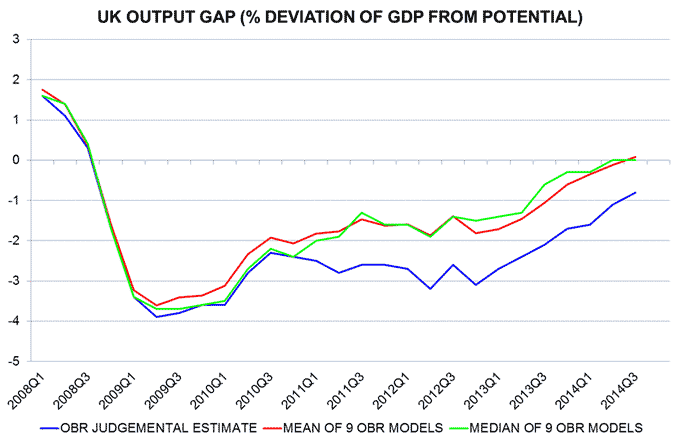UK fiscal projections flattered by suspect output gap assumption
Last week’s fiscal forecasts from the Office for Budget Responsibility (OBR) assume that the “output gap” – i.e. the deviation of GDP from its “potential” level – was -0.8% in the third quarter of 2014. This assumption, however, looks optimistic relative to the OBR’s formal methods for estimating the gap. A neutral assumption, based on these methods, is that it has now closed. This would imply that the existing budget deficit is entirely structural while domestic inflation is likely to overshoot OBR and Bank of England forecasts.
The OBR uses nine separate methods for estimating the output gap, detailed in a recent working paper*. The current estimates from these methods range from -2.3% to +1.6%, demonstrating a very high degree of uncertainty. The OBR’s assessment that the true figure is -0.8% has received little critical attention. This is probably because -0.8% is close to the mid-point of the range and broadly agrees with the MPC consensus view that economic slack is currently about 1% of GDP.
The range mid-point, however, gives a misleading impression of the balance of evidence across the nine methods. Detailed results in a spreadsheet** of supplementary information on the OBR’s website show that six of the nine estimates are zero or positive. Only two suggest a negative output gap larger than -0.8%. The mean and median across the nine methods are +0.1% and zero respectively – see chart.
The OBR projects that public sector net borrowing will be 5.0% of GDP in 2014-15, of which 0.8 percentage points is attributable to the economy operating below capacity (i.e. cyclically-adjusted net borrowing is forecast to be 4.2% of GDP). If the true output gap is zero rather than -0.8%, there is an additional “structural” fiscal shortfall to be corrected of 0.8% of GDP, equivalent to £15 billion per annum.
A zero gap now, meanwhile, implies that it will turn significantly positive next year, based on OBR and Bank of England growth forecasts, pushing up domestic inflation. As previously noted, an upswing in domestic inflation is already under way, with the annual increase in the deflator for gross value added at a two-year high in the third quarter, based on preliminary data.
*Working Paper No. 5 by Jamie Murray, Output gap measurement: judgement and uncertainty.
**December 2014 Economic and Fiscal Outlook, Economy supplementary tables, table 1.18.

Reader Comments